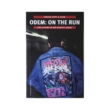Description
Title: Writing: Urban Calligraphy and Beyond
Author: Markus Mai, Arthur Remke, R. Klanten (Editor)
Paperback
Pages: 208
Language: English
Size: 11 x 9.5 x 0.3 inch. / 24 x 28 x 0,7 cm.
Published: 2004
Condition: Cover: 9.5/10 Inside: 10/10
Writing – Urban Calligraphy and Beyond is a cross-section of the formal expression of graffiti.
The book is structured didactically: the general and personal development of a design vocabulary of writing are successively shown in the chapters Tag/Throw Up and Letter/Word, which enables the reader to draw comparisons. The following chapter Analogy deals in a visual way with the background of forms and shapes and their relatives in urban space. The chapters 2D-3D and Object display the current developments towards sculptural works, still highly rooted in the formal expression of writing. Those chapters are the core of the book and provide insight in future developments. The last two chapters Graphics & Urban Art Activism mainly show links to and overlapping with design and art in public space.
It seems that Writing really met the zeitgeist: Within the next years several hard and soft cover editions were printed and sold. Today the book is out of print and has become a collector´s item for quite a few people.
Is there life after spray paint? Long condemned as vandalism, the publics perception of graffiti is slowly changing. Ubiquitous and with a natural affinity to architecture, this form of expression has not only established itself as a part of youth culture but has also become a fundamental aspect of the modern city.
An offspring of this scene, writing has become no less than contemporary urban calligraphy. While the classic New York style of writing was once limited to the world of street gangs, it has now left its mark on virtually all visual disciplines. Strictly speaking the arrangement of spaces by outlines, writing has become an invaluable influence and inspiration, especially in the realms of graphic design, motion graphics, fashion, packaging and architecture.
Compiled by Berlin activists and designers Markus Mai and Arthur Remke, the book Writing surveys this appropriation of public space and examines the detailed fusion of analogue writing and digital design as well as post-graffiti concepts. Broken down into the chapters tags, throw-ups, lettering, objects, graphic design and street art, the content documents the current, changing influences of writing, art and graphics. The featured work ranges from designs done in pencil, marker and spray paint to architectural models, which implement writings calligraphy as three-dimensional objects or buildings.
This book presents aspects of Writing’s development in the following chapters: Foreword and History – Tag/Throw up – Letter/Word – 2D/3D – Analogy – Object – Graphics – Urban:: Art :: Activism
It also answers questions such as: what is Writing? How do Writers do it? Why does Writing look the way it does? Where are Writing’s boundaries? Whereto will Writing develop in the future?
This book is a must for any graffiti enthusiast or anyone interested in the culture of writing and graffiti. Writing (the term used for quick marker tags or names) is addressed as an artform, and this book beautifully illustrates the complexity of the styles and aesthetics of these quick and furtive gestures. The book is full of samples of different letterforms and common shape styles found in writing, and the majority of work is from writers based in Germany and elsewhere in the world (a refreshing perspective away from the NYC graffiti culture). The book also addresses artwork which derives its roots from the graffiti and writing culture: digital pieces, collage, photography, and 3d work are all displayed, explained, and analyzed. The layout of the book is crisp, clean, and a pleasure to read.










Reviews
There are no reviews yet.